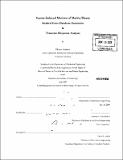Vortex-induced motions of marine risers : straked force database extraction & transient response analysis
Author(s)
Chasparis, Filippos
DownloadFull printable version (20.83Mb)
Alternative title
Straked force database extraction & transient response analysis
Other Contributors
Massachusetts Institute of Technology. Dept. of Mechanical Engineering.
Advisor
Michael S. Triantafyllou.
Terms of use
Metadata
Show full item recordAbstract
In part I of the thesis, we extend a methodology to extract a VIV hydrodynamic database from field data to accommodate partially straked cylinders. There are two databases, each consisting of the lift and added mass coefficients as functions of reduced velocity and amplitude of response; the first for the bare part of the riser, and the second for the straked part. First, the program VIVA together with nominal force databases obtained from laboratory hydrodynamic experiments is used in order to get an initial prediction of the riser response under a particular flow profile. The nominal databases are then altered in a systematic way until the new VIVA predicted response best matches the measured field response, thus resulting in optimal databases. In part II of the thesis, we show using experimental data on a model riser that lock-in of long flexible risers placed in sheared or uniform cross-flows is a much richer phenomenon than lock-in of flexibly-mounted rigid cylinders under similar conditions. In particular, we find that the frequency content of the riser response may be either narrow-banded around a single dominant frequency (Type I response) or distributed along a relatively broad range of frequencies (Type II response). Distinct transition from Type I to Type II response, and vice versa, can occur several times within a single experimental record. Type I responses reveal features of a quasi-periodic oscillation, often accompanied by large 3rd harmonic components in the acceleration and strain signals, increased correlation length, stable riser trajectories, and monochromatic traveling or standing waves. (cont.) Type II responses, on the other hand, are characterized by features of chaotic oscillation with small or non-existent 3rd harmonic components in the acceleration and strain signals, reduced correlation length, and a continuous spectrum.
Description
Thesis (S.M. in Mechanical Engineering and Naval Architecture and Marine Engineering)--Massachusetts Institute of Technology, Dept. of Mechanical Engineering, 2009. Includes bibliographical references (p. 55-58).
Date issued
2009Department
Massachusetts Institute of Technology. Department of Mechanical EngineeringPublisher
Massachusetts Institute of Technology
Keywords
Mechanical Engineering.